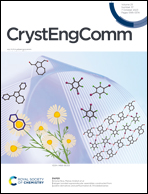Fabrication of two 2D Cu-based coordination polymers via a secondary ligand adjustment and a derived Cu/Cu2O heterojunction for an enhanced dye removal capacity†
Abstract
Organic dye pollutants have become a major concern owing to their harmful nature to the environment, and removing and separating them should be one of the best remedies. Herein, two two-dimensional (2D) Cu-based coordination polymers (CPs) [Cu(3-dpye)(OX)]n (Cu-CP-1) and [Cu(3-dpyb)(OX)]n (Cu-CP-2) [3-dpye = N,N′-bis(3-pyridinecarboxamide)-1,2-ethane, 3-dpyb = N,N′-bis(3-pyridinecarboxamide)-1,4-benzene, OX = oxalate] were successfully synthesized by tuning the secondary ligands under hydrothermal conditions and applied to selectively adsorb and photodegrade anionic dyes, such as methyl orange (MO) and Congo red (CR), from an aqueous solution. The Cu-CPs exhibited different compositions because of the different N-donor ligands, which were used as precursors for the preparation of Cu/Cu2O heterojunctions (Cu@C-1, Cu@C-2, Cu@N-1, Cu@N-2, Cu@S-1 and Cu@S-2). Doping a foreign element into the intrinsic Cu-based materials is an effective way to enhance both the adsorbing capacity and the photocatalytic activity. Benefiting from the formation of Cu/Cu2O and graphite-type carbon sheets, the maximum adsorption capacities of Cu@N-2 at room temperature are 2097.84 mg g−1 for MO and 1942.85 mg g−1 for CR in 240 min, while the photocatalytic degradation rates are 95.23% for MO and 99.25% for CR after 4 h.



 Please wait while we load your content...
Please wait while we load your content...